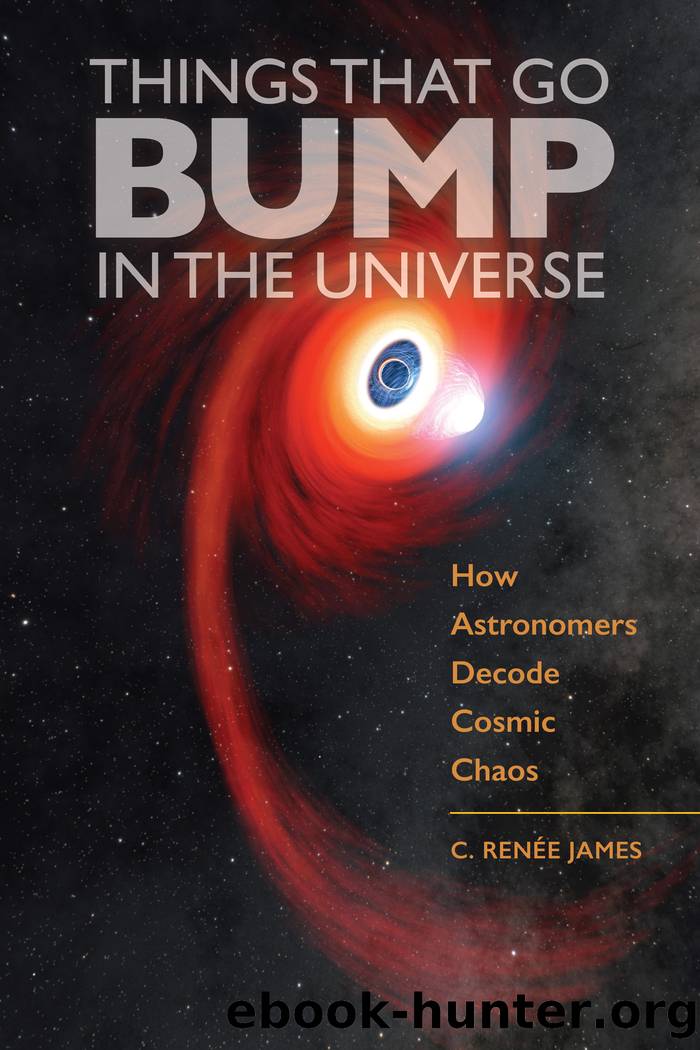Things That Go Bump in the Universe by C. Renée James

Author:C. Renée James
Language: eng
Format: epub
Publisher: Johns Hopkins University Press
Published: 2023-04-15T00:00:00+00:00
â Clash of the Titans â
The universe doesnât care how a neutron starâs weight limit is surpassed. All that matters is that it is surpassedâwhether by the collapse of a too-massive core of a single star or by the merging of objects that individually are well below the maximum mass allowed for a neutron star. In the case of the Hulse-Taylor binary, which will come together in an upcoming geologic era (stay tuned!), the neutron stars weigh in at 1.44 and 1.39 times the mass of the Sun, each essentially at the Chandrasekhar limit. For now, these two are fine, but in 300 million years, they will merge to create something well over 2.5 times the mass of the Sun. When they do, the resulting object will likely be a black hole, but only after a fierce battle. As it turns out, itâs one thing for a stellar core to implode under its own weight, but itâs another thing entirely when two neutron stars experience a close gravitational embrace.
âIt isnât a nice friendly handshake upon coming together. Itâs more of a ripping-apart explosion,â astronomer Jeff Cooke explained animatedly, telling me this story as a prelude to another, seemingly unrelated one. âBy the end, the intense gravity starts shredding them apart, and they start to get really stretched out, spilling neutrons everywhere. And thatâs messy, because if you have a neutron thatâs not inside an atom or in a neutron star, it only lasts for about 15 minutes.â
That fact feels like it should get much higher billing in high school chemistry classes. Protons, the positively charged heavyweight cousins of neutrons, apparently have no expiration date, even when left out in the open. At least, thatâs what decades of underground Cherenkov detectors like Kamiokande II and its global siblings have told scientists. But making up a large percentage of the familiar material inventory of the universe are particles that, left to their own devices, will self-destruct within a lunch break. When two neutron stars come together, torrents of these particles are unleashed, and the neutron clocks start ticking. Once their internal timers run out, the neutrons spray the area with protons, electrons, and, to satisfy the universal accountant, the antimatter version of a neutrino.
Forcefully shredded from the gravitational prison of the neutron stars, the newly converted protons and escaped neutrons fuse to form atomic nuclei, the very things that the massive starâs core squashed out of existence when it collapsed. In the ensuing mosh pit of protons, neutrons, and atomic nuclei, heavier and heavier elements are forged. It is all in a dayâs work for this stellar alchemist to whip up the Earthâs weight in gold, and along with that comes a flood of radioactive elements that will gradually shed bits and pieces of themselves, along with gamma rays, for up to thousands of years.
The electromagnetic energy released from the initial flurry of destruction is considerable, perhaps a tenth of a foe, but this figure pales in comparison to the full foe that two white dwarfs conjure up upon colliding.
Download
This site does not store any files on its server. We only index and link to content provided by other sites. Please contact the content providers to delete copyright contents if any and email us, we'll remove relevant links or contents immediately.
| Aeronautics & Astronautics | Astronomy |
| Astrophysics & Space Science | Comets, Meteors & Asteroids |
| Cosmology | Mars |
| Solar System | Star-Gazing |
| Telescopes | UFOs |
Tools of Titans by Timothy Ferriss(7737)
Turbulence by E. J. Noyes(7660)
Astrophysics for People in a Hurry by Neil DeGrasse Tyson(4973)
Secrets of Antigravity Propulsion: Tesla, UFOs, and Classified Aerospace Technology by Ph.D. Paul A. Laviolette(4863)
Design of Trajectory Optimization Approach for Space Maneuver Vehicle Skip Entry Problems by Runqi Chai & Al Savvaris & Antonios Tsourdos & Senchun Chai(4807)
Room 212 by Kate Stewart(4703)
Pale Blue Dot by Carl Sagan(4573)
The David Icke Guide to the Global Conspiracy (and how to end it) by David Icke(4348)
A Journey Through Divination and Astronomy by Publishing Pottermore(4233)
Apollo 8 by Jeffrey Kluger(3481)
Goodbye Paradise(3413)
Losing the Nobel Prize by Brian Keating(3409)
COSMOS by Carl Sagan(3313)
The Five People You Meet in Heaven by Mitch Albom(3295)
Brief Answers to the Big Questions by Stephen Hawking(3218)
How to Read Water: Clues and Patterns from Puddles to the Sea (Natural Navigation) by Tristan Gooley(3210)
The Order of Time by Carlo Rovelli(3052)
How to Read Nature by Tristan Gooley(3048)
A Brief History of Time by Stephen Hawking(2795)
